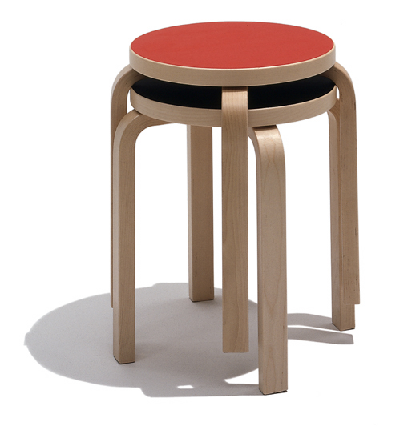Design Classics
Wooden Stool, 1932–1933
Designer: Alvar Aalto
Manufacturer: Herman Miller

Hugo Alvar Hendrik Aalto (1898 – 1976) was Finland’s most famous and influential architect and designer. After extensive travels in Europe in the 1920s, Aalto became a proponent of the modern design movement back in his native country. But he was concerned that “objects that properly can be given the label rational often suffer from a noticeable lack of human qualities.” So he committed himself to developing a particularly Scandinavian version of the International style using curvilinear forms and natural materials that brought humanity as well as a regional identity inspired by Finland’s lakes and forests.
WHAT
Beginning in the mid-1920s, Aalto and his wife, Aino Marsio, experimented with the bending of wood and plywood as a way to bring tactile qualities to mass-produced products as a natural extension of his architecture. Given Finland’s forestry industry, Aalto’s material of choice was birch – a clear, fine-grain renewable wood. His exploration focused on the design of a bent, solid birch L-leg attached to a solid top. To make the bend, Aalto’s innovation was to saw open the end of a solid piece of birch and glue thin pieces of wood into the groove so he could bend the wood to 90 degrees. He used this L-leg as the basis for chairs, tables and beds. Legend has it that Aalto threw a prototype stool across the room and when it emerged unscathed he was convinced of its strength and declared, “We’ll sell thousands of these.” Aalto was off in his predictions – more than 1.5 million of the space-saving stacking stools have been sold since being first exhibited in 1933 at the British department store Fortnum and Mason. The success of the stool led Aalto and some of his colleagues to form Artek in 1935 as their own manufacturing and design centre.
WHY
Aalto thought of architecture and furniture as “branches of the same tree” and his buildings as furniture are, not surprisingly, typically described as organic because of their soft forms and natural materials. In this, they are different from the factory-inspired aesthetic of many German and French modern designers. While Aalto’s stool doesn’t call attention to itself, it is nonetheless ingenious and simple. For years, its durability and low price made it a favourite – with bright linoleum seats – in design-conscious schools, institutions and kids’ bedrooms around the world.
National Post, June 22, 2006.
